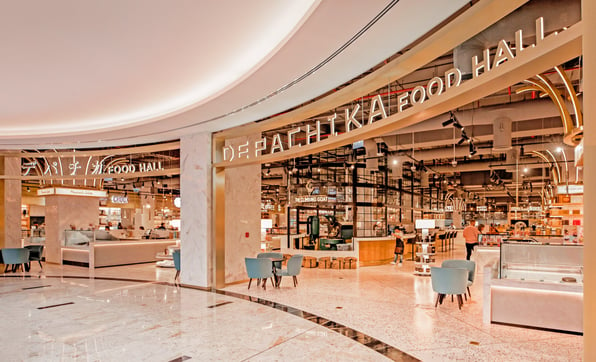From the compact craftsmanship of Izakayas to immersive Depachika gourmet food halls found in the basements of department stores, we delve into some of the most unique concepts that set Japanese gastronomy apart.
YOKOCHO (ALLEYWAY DINING)

Yokocho, translating to "alleyway" or "backstreet," are narrow lanes packed with close-knit eateries and bars. Found predominantly in bustling urban centres, these charming alleys offer a nostalgic peek into traditional post-war Japan.
After World War II, the nation underwent significant reconstruction efforts, and many urban areas were rebuilt with narrow alleyways and compact buildings.
These Yokocho alleys emerged as vibrant hubs of local commerce and community interaction, offering affordable dining options and a sense of camaraderie among residents.
Each Yokocho venue, often specialising in specific dishes like yakitori (grilled skewered chicken), tempura, or ramen, allows visitors to meander through these atmospheric alleys, indulging in a diverse array of culinary offerings while rubbing shoulders with other diners in a distinctly social setting.
Some of the most iconic Yokochi dining spots include Omoide Yokocho (Memory Lane) in Shinjuku and Ebisu Yokocho in Ebisu, both famous for their vibrant nightlife among locals and visitors alike.
IZAKAYA

Izakayas, ubiquitous throughout Japan's urban landscapes, are beloved for their casual, “pub-like” ambiance.
These cosy establishments boast an extensive selection of small, shareable dishes paired with an array of alcoholic beverages, including beer, sake, and shochu. Renowned for their vibrant atmosphere, Izakayas are the go-to destination for after-work gatherings, leisurely dinners with friends, and late-night socialising.
With their roots tracing back to the Edo period (1603–1868) Izakayas were initially small sake stalls that popped up near major thoroughfares, serving passers-by with sake and small dishes to accompany the drinks.
Evolving from this humble concept, Izakayas are now fundamental to the very fabric of communities throughout Japan. Adapting with time, they are now multifaceted dining establishments deeply ingrained in Japanese culinary culture, blending both traditional and modern dishes.
An integral component of urban nightlife, Izakayas serve as focal points within entertainment districts of all major Japanese cities from Tokyo to Sapporo.
KAITENZUSHI (CONVEYOR BELT SUSHI)

Kaiten-zushi, or “rotation sushi”, have evolved significantly since their inception. Originally introduced in the 1950s in Osaka, Japan, by restaurateur Yoshiaki Shiraishi, conveyor belt sushi revolutionized the sushi dining experience by offering a more efficient and affordable way to enjoy sushi.
These F&B venues use a simple conveyor belt system for the delivery of meals to guests, streamlining service but also fostering a sense of exploration and spontaneity, inviting diners to view each of the restaurants prepared dishes up close.
By combining innovation with accessibility and variety, Kaitenzushi establishments epitomize the fusion of tradition and modernity, redefining the way we perceive and engage with Japanese cuisine.
Yo! Sushi is perhaps the most recognisable conveyor belt sushi brand outside of Japan. First set up in London in 1997, the company has since seen massive expansion across Europe, the Middle East, and North America.
THEMED RESTAURANTS AND CAFES
Japan is renowned for its theatrical themed restaurants, ranging from maid cafes and robot restaurants to cat cafes and ninja-themed eateries. Some of the most famous themed restaurants in Japan include Kawaii Monster Café, Harajuku and Vampire Cafe in Tokyo, Ginza district.
These quirky F&B venues offer something unique—a blend of dining and entertainment where the experience is just as important as the food served.
Costumed staff, fantastical brand narratives, and a departure from the normal adds an element of fun and novelty to the dining scene across Japanese cities,
TEPPANYAKI RESTAURANTS

Teppanyaki restaurants are famous for their adept chefs, captivating diners with their swift and skillful manoeuvres atop flat iron grills.
Generally, Teppanyaki dining is often associated with special occasions and celebrations due to its interactive nature and the theatrical performances of the chefs. As a result, many Teppanyaki restaurants, especially those located in urban centres and tourist destinations, tend to lean towards upscale dining experiences where the overall enjoyment and experience of the customer is an essential component.
However, there are also Teppanyaki restaurants that offer more casual settings, catering to locals and visitors looking for a less formal dining experience. These restaurants may feature simpler decor, more modest pricing, and a focus on quality ingredients without the extravagant extras often found in upscale establishments.
DEPACHIKA DINING

Depachika, the bustling basement food floors within Japan's department stores can be found across Japan's urban centres.
These bustling ecosystems are a treasure trove of gourmet delights, offering a wide array of ready-to-eat meals, bento boxes, fresh produce, baked goods, and artisanal foods.
Originally, Depachikas were primarily known for their selection of fresh produce and grocery items, serving as convenient shopping destinations within department stores. As consumer preferences shifted and culinary tastes diversified, Depachikas began to heavily incorporate gourmet food elements offering a wide array of prepared foods, delicacies, and international cuisines.
Today, Depachika dining has become synonymous with culinary excellence, featuring artisanal foods, specialty ingredients, and renowned chefs showcasing their craft.
The model also has huge relevance globally—best illustrated by our homage to Depachika dining in our food hall development project for Nakheel Mall at the heart of Palm Jumeirah, Dubai.
Fittingly titled “Depachika”, we wanted to showcase the same kind of energy, vibrancy and upscale gourmet offerings, which is also a key strategy we’ve utilised for other food hall projects across the Middle East where the F&B landscape is undergoing its own kind of revolution of dining spaces and urban community culture.
DRAWING INSPIRATION FOR FUTURE F&B VENUES
The exploration of these distinct Japanese F&B concepts offers valuable insights for the development of future dining venues.
From the intimate charm of Yokocho alleyway dining to the casual conviviality of Izakayas and the innovative efficiency of Kaitenzushi, each concept underscores the importance of creating immersive culinary experiences that cater to diverse tastes and preferences.
While themed restaurants and Teppanyaki establishments showcase the power of storytelling and interactive dining, Depachika dining exemplifies the power of blending gourmet excellence with convenience
-1.png?width=3330&height=698&name=TGP%20International%20Logo%20White%20(1)-1.png)



